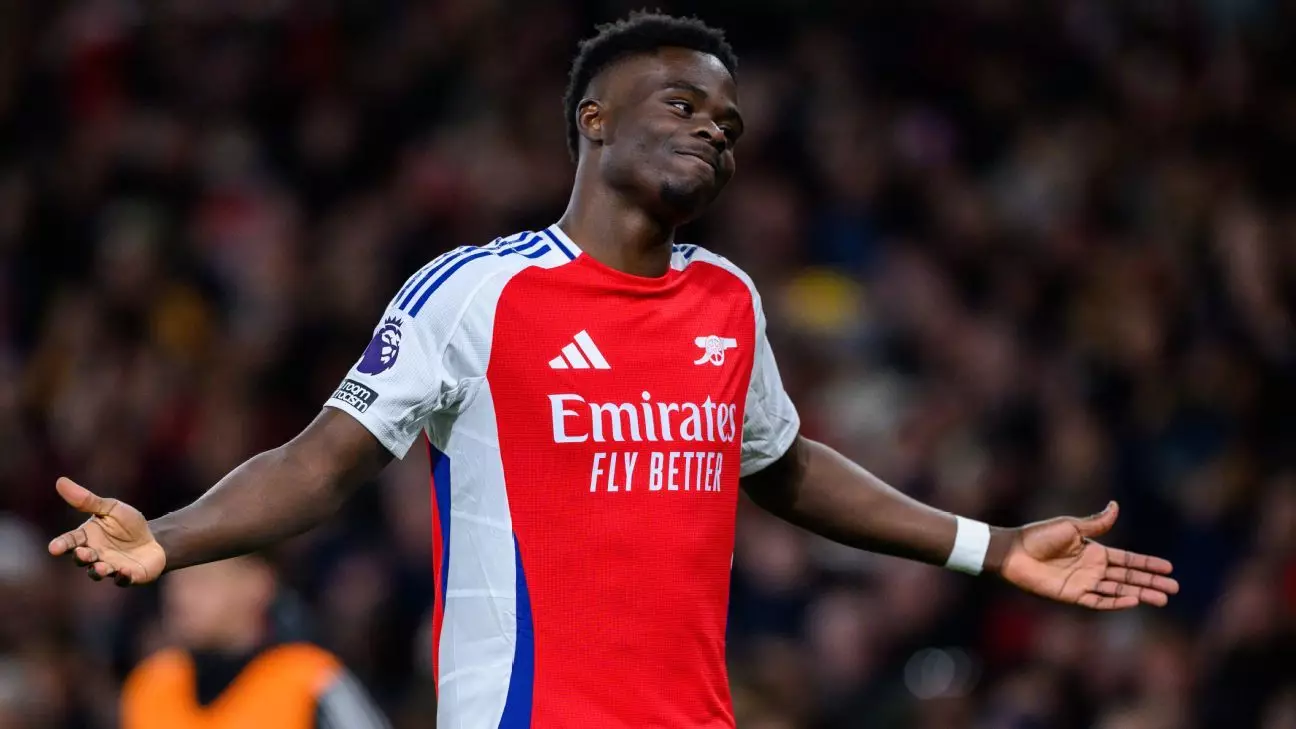In a moment characterized by both hope and necessity, Arsenal forward Bukayo Saka’s return from injury is a turning point that could define the remainder of the Gunners’ season. With Saka sidelined for 100 days due to hamstring surgery, the burden on his young shoulders seems to weigh heavily against the backdrop of a faltering Arsenal campaign. As the team faced Fulham in what was both a critical Premier League match and a display of resilience, Saka’s appearance in the 66th minute and subsequent goal within mere moments showcased the kind of immediate impact that both the player and the club desperately needed.
Under the watchful eye of Mikel Arteta, Saka’s quick adjustment served as a beacon of energy in an arena that had witnessed its fair share of disillusion. The Emirates Stadium had been longing for that spark—Saka’s return served not only as a solution to a tactical issue, but also as a rallying cry for fans and players alike. “He lifted the stadium,” said Arteta, emphasizing the palpable atmosphere shift that accompanied Saka’s entry.
Arsenal’s Offensive Struggles: A Team in Need of a Catalyst
Before Saka re-entered the game, Arsenal had wandered through large stretches of the match, grappling for creativity and decisiveness in the final third. The win over Fulham, achieved with a 2-1 scoreline, materialized from a moment of maverick brilliance rather than a cohesive team effort—epitomized by Mikel Merino’s clever yet fortuitously deflected goal. With Kai Havertz and Gabriel Jesus also sidelined, the Gunners’ attacking play had stagnated, leaving fans in a state of uncertainty. A conceptual framework built on potential could only be achieved if the attacking line found its footing, and Saka’s instant contribution provided hope.
Not only did Saka’s presence on the pitch spark creativity, but it also underlined a broader discussion about the squad’s depth or the lack thereof. With the UEFA Champions League quarterfinal against Real Madrid looming on the horizon, Arsenal’s coaching staff needs to find a way to reinstate a level of offensive fluidity that had grown dormant in Saka’s absence. The team’s projections for success in both league and European competitions may heavily hinge on players’ returns to form, making each match, especially those leading to the Madrid clash, a testing ground for potential revitalization.
Defensive Dilemmas: The Fragile Backbone of a Great Team
However, Arsenal’s revival cannot solely rest on the principles of attack; the club faces issues that extend beyond offensive potency. The uncertainty surrounding the fitness of their key defensive players, particularly Gabriel Magalhães, presents significant challenges. The sight of the Brazilian center-back limping off the field early in the match raised red flags, amplifying concerns regarding the strength of the squad. Such situations render the Gunners vulnerable; each injury reverberates across the team’s collective psyche.
Gabriel’s partnership with William Saliba has been the bedrock on which Arteta has constructed a credible defensive line, and any setback here carries implications that extend beyond this match. With injuries compounding the squad’s woes, defenders like Jakub Kiwior must adapt seamlessly and quickly. The gaps left by underperforming players present an open invitation for opponents like Fulham to capitalize, an affront that the Gunners cannot afford as they transition towards key matches ahead.
Statistical Excellence Amidst Team Struggles
Amid the turmoil, the statistical narrative of Bukayo Saka’s career remains a green light amidst the chaos. Now, at just 23 years old, Saka has achieved the impressive milestone of scoring and assisting 10 or more goals across all competitions for three consecutive seasons, a feat that hasn’t been matched by an Arsenal player since Alexis Sánchez. This achievement, juxtaposed with the current team’s struggles, holds vital weight—a reminder that quality often shines brightest in times of adversity.
Saka represents the promise of youth and the potential for future greatness, and his quick recalibration to the pitch speaks volumes to his character. The affection exhibited in his celebration alongside the club’s physical performance coach encapsulates this journey—a personal triumph within the larger struggle of the team. It’s this connection that offers undercurrents of resilience and teamwork, emphasizing the necessity of unity in the face of obstacles.
The task ahead remains monumental, yet Saka’s presence offers clarity. His ability to create goals when pressure mounts serves as a panacea for Arsenal’s broader ailments. As the side prepares for a critical juncture against Real Madrid, the expectation is not solely for individual brilliance but a collective reaffirmation of Arsenal’s brand as a competitive force. The challenges remain significant, but with figures like Saka leading the charge, the possibility for revival remains not just a dream but a palpable reality.


Leave a Reply